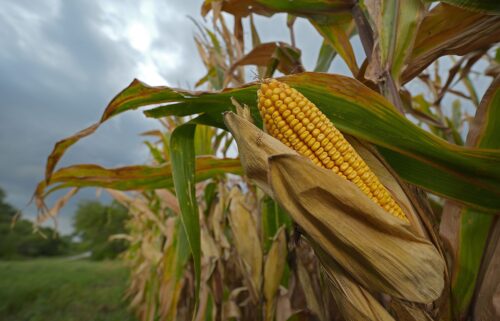The comb jelly, one of the oldest animals on Earth, can fuse with another
By Amanda Schupak, CNN
(CNN) — Late one summer night in 2023, Kei Jokura entered the Marine Biological Laboratory in Woods Hole, Massachusetts, excitedly carrying a blob in a beaker. The biologist had just come from the first floor, where tanks held a colony of gelatinous comb jellies.
The blob was bigger than others, and it looked as though two of the jellies had merged into one. “I couldn’t believe my eyes at first,” recalled Jokura, who was then a postdoctoral researcher at the UK’s University of Exeter.
Mariana Rodriguez-Santiago, a postdoctoral researcher at Colorado State University, was working on her own project when Jokura appeared. “We were all amazed and astonished, thinking, ‘How can they fuse and still be swimming and moving around like a unit?’” she said. She grabbed a pipette and gently poked one of the jellies. It squirmed. Simultaneously, so did the one to which it seemed to be attached. “We thought, ‘Are they able to feel the same thing? Are they one individual? Two individuals? How can we disentangle this?’” she recalled.
Over the next few weeks, Rodriguez-Santiago helped Jokura combine multiple pairs of the comb jellies, scientifically known as Mnemiopsis leidyi, to see what happened. The findings of the investigation led by Jokura, published October 7 in the journal Current Biology, showed that not only could two jellies fuse their bodies, but their nervous and digestive systems fused as well. Two effectively became one.
“The fusion phenomenon has definitely brought up many interesting questions, such as which genes are involved in fusion, what happens to neural signaling, and what defines ‘self’ and ‘nonself,’” said Jokura, now a postdoctoral researcher at Japan’s National Institute for Basic Biology. “Each of these themes has the potential to challenge our fundamental understanding of biology.”
Comb jellies are found all around the world in coastal waters and the deep ocean. Though they look similar to jellyfish, they don’t sting and belong to a different phylum, Ctenophora, which is Greek for “comb-bearers.” They are named for their combs, rows of hairlike appendages called cilia they use to move through the water.
Ctenophores are one of, if not the, oldest animals on Earth — quite possibly a sister to all other animals in the tree of life, so “they provide a really unique opportunity to study fundamental aspects of nervous system function,” said Rodriguez-Santiago, coauthor of the study.
“They belong to a group of animals which were there when the very first animals evolved,” said Pawel Burkhardt, an evolutionary biologist and researcher at the University of Bergen in Norway. Burkhardt was coauthor of another October report on M. leidyi, published in the journal PNAS, showing that the jelly is able to develop backward, reverting to an earlier life stage following stress. He was not involved in the study that appeared in Current Biology.
“The two recent papers highlight that ctenophores have the opportunity to adapt quickly to changing environments and that their developmental programs are potentially more flexible than seen in other animals,” he said.
Fusion as a survival mechanism
It also may be, Jokura’s paper suggests, that ctenophores lack the protective allorecognition mechanism that allows one organism to tell the difference between its own cells and tissues and those of another organism. In humans, for example, allorecognition underpins the organ rejection that happens in transplant surgeries.
Jokura was studying how M. leidyi responds to light when he discovered two injured specimens had become conjoined. Curious to recreate the phenomenon, he and Rodriguez-Santiago began experimenting. They sliced off parts of several jellies and placed excised pairs together in petri dishes overnight.
Nine out of 10 pairs fused successfully, resulting in animals with two sensory organs and two sets of anal openings, whereas typical jellies have only one of each.
As it turned out, the fusion happened much more quickly than the researchers expected, according to Jokura. “To observe the fusion process — when and how it happens — we performed time-lapse imaging,” he said. The research team placed cut jellies near each other and waited.
At first, the jellies continued to contract their muscles independently. Within an hour, their rhythmic movements started to synchronize. By the two-hour mark, they were in sync. When poked gently on one side, both sides of the combined organism contracted in unison.
Imaging demonstrated another layer to the fusion: The animals’ digestive systems also combined. The researchers fed a fluorescently labeled brine shrimp into one mouth of a pair of jellies that had been fused for two days. Then the team traced the meal’s movement through a microscope.
The digested particles traveled down the digestive canal, crossed the fusion boundary and entered into the digestive tract of the other animal — “and the other individual could poop out the food,” Rodriguez-Santiago explained. Eventually, the waste was expelled by both anuses, each in its own time.
Future comb jelly research
What Rodriguez-Santiago finds most interesting about the study is the way it calls into question what she thought of as “pretty hard boundaries” between self and other.
Allorecognition is considered a protective adaptation because it enables a body to reject foreign cells that could introduce dangerous diseases. But these animals “bypass that sensory rejection to then potentially have an even better chance of survival,” she said.
Burkhardt believes the findings may lead scientists toward an understanding of when animals evolved allorecognition and how simple nervous systems form and process information.
Jokura wants to study further how the jellies’ nervous systems mesh following fusion. “I would like to investigate how their ‘thoughts’ are integrated,” he said. “By visualizing neural networks, we might be able to explore something like the fusion of consciousness.”
Amanda Schupak is a science and health journalist in New York City.
The-CNN-Wire
™ & © 2025 Cable News Network, Inc., a Warner Bros. Discovery Company. All rights reserved.

